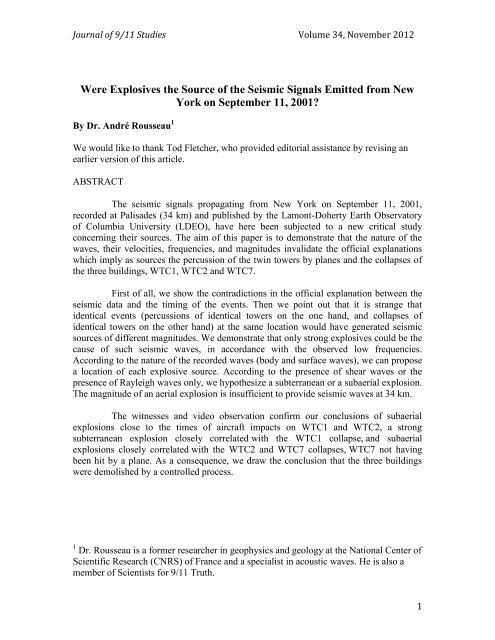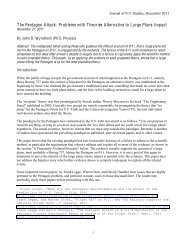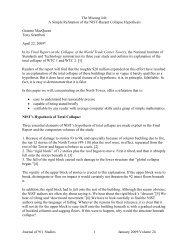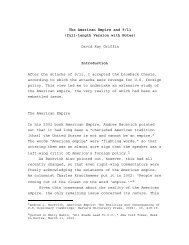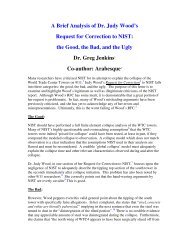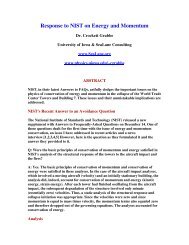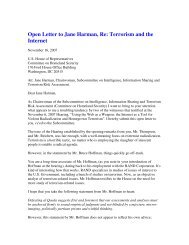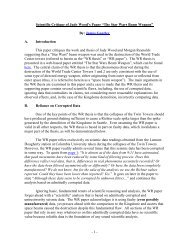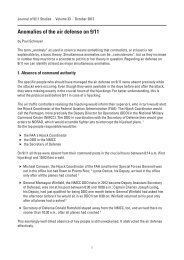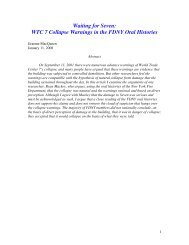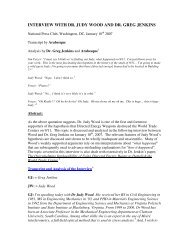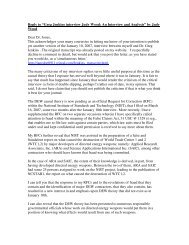Create successful ePaper yourself
Turn your PDF publications into a flip-book with our unique Google optimized e-Paper software.
<strong>Journal</strong> <strong>of</strong> 9/<strong>11</strong> <strong>Studies</strong> Volume 34, November 2012Were Explosives the Source <strong>of</strong> the Seismic Signals Emitted from NewYork on September <strong>11</strong>, 2001?By Dr. André Rousseau 1We would like to thank Tod Fletcher, who provided editorial assistance by revising anearlier version <strong>of</strong> this article.ABSTRACTThe seismic signals propagating from New York on September <strong>11</strong>, 2001,recorded at Palisades (34 km) and published by the Lamont-Doherty Earth Observatory<strong>of</strong> Columbia University (LDEO), have here been subjected to a new critical studyconcerning their sources. The aim <strong>of</strong> this paper is to demonstrate that the nature <strong>of</strong> thewaves, their velocities, frequencies, and magnitudes invalidate the <strong>of</strong>ficial explanationswhich imply as sources the percussion <strong>of</strong> the twin towers by planes and the collapses <strong>of</strong>the three buildings, WTC1, WTC2 and WTC7.First <strong>of</strong> all, we show the contradictions in the <strong>of</strong>ficial explanation between theseismic data and the timing <strong>of</strong> the events. Then we point out that it is strange thatidentical events (percussions <strong>of</strong> identical towers on the one hand, and collapses <strong>of</strong>identical towers on the other hand) at the same location would have generated seismicsources <strong>of</strong> different magnitudes. We demonstrate that only strong explosives could be thecause <strong>of</strong> such seismic waves, in accordance with the observed low frequencies.According to the nature <strong>of</strong> the recorded waves (body and surface waves), we can proposea location <strong>of</strong> each explosive source. According to the presence <strong>of</strong> shear waves or thepresence <strong>of</strong> Rayleigh waves only, we hypothesize a subterranean or a subaerial explosion.The magnitude <strong>of</strong> an aerial explosion is insufficient to provide seismic waves at 34 km.The witnesses and video observation confirm our conclusions <strong>of</strong> subaerialexplosions close to the times <strong>of</strong> aircraft impacts on WTC1 and WTC2, a strongsubterranean explosion closely correlated with the WTC1 collapse, and subaerialexplosions closely correlated with the WTC2 and WTC7 collapses, WTC7 not havingbeen hit by a plane. As a consequence, we draw the conclusion that the three buildingswere demolished by a controlled process.1 Dr. Rousseau is a former researcher in geophysics and geology at the National Center <strong>of</strong>Scientific Research (CNRS) <strong>of</strong> France and a specialist in acoustic waves. He is also amember <strong>of</strong> Scientists for 9/<strong>11</strong> Truth.1
<strong>Journal</strong> <strong>of</strong> 9/<strong>11</strong> <strong>Studies</strong> Volume 34, November 2012INTRODUCTIONWhen major shocks occur at the Earth's surface or at depth, waves <strong>of</strong> different types,magnitudes and speeds may move out from the source location. Such waves can bedetected by seismometers located at recording stations and the data from the recordingscan be analyzed to learn many details <strong>of</strong> the source events. Seismic signals were recordedat stations in New York and four neighbouring states on September <strong>11</strong>, 2001 during theperiod when the North and South Towers (WTC1 and WTC2, respectively) were struckby airliners and collapsed, as well as during the collapse <strong>of</strong> Building 7 <strong>of</strong> the WTC,which had not been hit by a plane.Data from the Palisades, NY recording station, located 34 km north-north-east <strong>of</strong>Manhattan, published by the Lamont-Doherty Earth Observatory <strong>of</strong> Columbia University(LDEO), provide the most detailed seismic waveforms for analysis, particularly for thedetermination <strong>of</strong> the locations (surface or underground) and timing <strong>of</strong> the events thatcreated the seismic waves.Some authors have been puzzled in their analysis <strong>of</strong> signals recorded for the events at theWorld Trade Center, as the contradictions are significant. They are particularly intriguedby the presence <strong>of</strong> seismic "peaks" before the collapses. (See MacQueen, 2009). This textfocuses on the study <strong>of</strong> the seismic signals from Palisades. The new interpretationpresented here renders the assertions <strong>of</strong> the seismic analysis <strong>of</strong> the events at the WTC, aspresented by the government in the NIST and other reports, null and void. On thecontrary, all the documented evidence points to explosions as the source <strong>of</strong> the recordedseismic signals.COMPOSITION OF DIFFERENT WAVEFORMSFive waveforms will be analyzed below. They are attributed by the LDEO team tospecific causes, as follows:1. the signals that, according to LDEO, match the moment when the planes hitWTC1 and WTC2, respectively, shown in figures 1a and 1b;2. the signals that match the collapses <strong>of</strong> WTC1 and WTC2, respectively, shown infigures 2a and 2b; and3. the signal that shows the collapse <strong>of</strong> WTC7, shown in Figure 2c.The analysis presented here will question LDEO's identifications <strong>of</strong> the causes <strong>of</strong> thewaveforms.2
<strong>Journal</strong> <strong>of</strong> 9/<strong>11</strong> <strong>Studies</strong> Volume 34, November 2012Determination <strong>of</strong> the Timing <strong>of</strong> the Signals' OriginsIn these five cases the origin <strong>of</strong> the signals was attributed, by the seismologists whopublished the data, to the impacts <strong>of</strong> the planes or the collapses <strong>of</strong> the buildings (Kim etal. 2001; Irvine, 2001; H<strong>of</strong>fman, 2006). Normally in this type <strong>of</strong> study the time <strong>of</strong> originis known with great precision (to the millisecond), which is necessary in order tocalculate the propagation speed <strong>of</strong> the different waves. Unfortunately, that precision isnot possible for the events at the WTC. In this case, timing <strong>of</strong> the waves must becorrelated as well as possible utilizing video evidence.The video used in this study for the North Tower (WTC1) was from a recording made byCNN with a time stamp on the screen (H<strong>of</strong>fman, 2006), and the results were comparedwith the method utilized by LDEO (Kim et al. 2001). LDEO's method consisted <strong>of</strong>assigning an estimated speed <strong>of</strong> 2km/s for a Rayleigh wave (a type <strong>of</strong> surface seismicwave) that traversed several stations (see Figure 3) situated at various distances from thepoint <strong>of</strong> origin. The major inconveniences <strong>of</strong> this method are that the stations are notsituated on a straight line, and that the surface terrain in which the surface waves movevaries. The waves do not have the same speed <strong>of</strong> propagation as they pass throughdifferent materials.The Hudson River is located on a fault line that separates predominantly sedimentaryterrain on the west from crystalline and metamorphic rock on the east. These easternformations permit more rapid surface wave propagation than those found to the west,which explains why the path WTC-MANY (Fig. 3), the only site to the east <strong>of</strong> theHudson, was more rapid than all the other paths, situated to the west. In contrast, thestations at Palisades (34 km), at ARNY (67.5 km) and at TBR (51 km), provide similarresults because they are situated on similar geological formations. Finally, the enormousindeterminacy <strong>of</strong> 2 seconds in the calculations attempting to fix the time <strong>of</strong> origin <strong>of</strong> each<strong>of</strong> the signals, admitted by the LDEO authors themselves (Kim et al., 2001), oblige us toview the <strong>of</strong>ficial conclusions critically.Waveforms Attributed to the Planes Crashing Into the TowersThe waveforms that the LDEO team attributes to the impacts <strong>of</strong> the airliners into theTwin Towers are shown in figures 1a and 1b. Although the waveforms look somewhatsimilar, they are sufficiently different to raise questions about LDEO's analysis. Althoughthe cause <strong>of</strong> the two signals is similar -- the crashing <strong>of</strong> a plane, according to LDEO -- themagnitude (reflected by the amplitudes, or distribution on the vertical axis) <strong>of</strong> the twosignals is different. Further, the waves generated by the two events do not have the sameapparent velocity. The calculation <strong>of</strong> the propagation speeds, derived from the timesmeasured in the graphs <strong>of</strong> Figures 1a and 1b between the origins fixed according to thecorresponding crashes and the first wave arrivals – namely respectively <strong>11</strong>.7 and 15.8seconds - indicates roughly 2900 m/s for WTC1 and 2150 m/s for WTC2.A more serious difficulty with LDEO's attribution <strong>of</strong> the waveforms to plane impacts atthe Twin Towers is that even if the impacts had been considerably more energetic, these3
<strong>Journal</strong> <strong>of</strong> 9/<strong>11</strong> <strong>Studies</strong> Volume 34, November 2012signals could not have been generated by such impacts. The actual waves generated bythe crashes had to have been deadened before hitting the ground. Frequencies <strong>of</strong> wavesgenerated by explosions are on the order <strong>of</strong> 1 Hertz (1 Hz, or one cycle per second) --which is the case with the Rayleigh waves shown in figures 1a and 1b -- while those <strong>of</strong>crash impacts are above 10 Hz and are <strong>of</strong>ten around 100 Hz. Furthermore, the range <strong>of</strong>the recording instruments (0.6-5 Hz) cited does not allow for the recording <strong>of</strong> the highfrequencywaves that would be created by plane impacts. As to the theory <strong>of</strong> theoscillation <strong>of</strong> the Towers to explain these signals, as defended by Irvine (2001), it isinadequate because in such a case we would have had a "square" signal <strong>of</strong> long durationand a constant amplitude, while in actuality we observe a "bell-like" signal, representinga strong and brief explosion, which is particularly evident in the case <strong>of</strong> WTC2.Given that it is geophysically impossible to have two different propagation speeds fortwo waves <strong>of</strong> the same type at the same frequency travelling the same path only a fewminutes apart, one must bow to the evidence that the supposed origins <strong>of</strong> the recordedwaves are incorrect, and that they are not linked to the plane crashes but to another origin.The waveform data, far from suggesting the conclusion <strong>of</strong> LDEO that they were causedby plane impacts into the Towers, suggest instead two explosions with different timedisplacements from the moments <strong>of</strong> plane impact at each building. Further, the differencein the magnitude <strong>of</strong> the two signals can only be linked to differences in the volume <strong>of</strong>explosives and/or their distance from the surface.Waveforms Attributed to the Collapse <strong>of</strong> the TowersWhile the Twin Towers had approximately the same mass, the same height and size, andthe same type <strong>of</strong> internal structure (as well as essentially identical points <strong>of</strong> origin <strong>of</strong> theseismic wave-data in terms <strong>of</strong> distance to the recording station), the signals attributed tothe collapses <strong>of</strong> WTC1 and WTC2, instead <strong>of</strong> being similar as one would suppose fromthe <strong>of</strong>ficial thesis, are in fact very different. They differ in their form, their composition,and especially in their apparent propagation speed, as calculated from the <strong>of</strong>ficial origintime.In fact, the recording for WTC1 (Fig. 2a) demonstrates the three types <strong>of</strong> wavecharacteristic <strong>of</strong> a brief explosive source confined in a compact, solid material: a P wavewith a speed <strong>of</strong> 6000 m/s, the typical value for a very consolidated crystalline orsedimentary terrain (which is the case in the bedrock <strong>of</strong> Manhattan), an S wave with aspeed <strong>of</strong> 3500 m/s, and a surface wave with a speed <strong>of</strong> 1800 m/s (a Rayleigh wave).These values match those registered from an earthquake or seismic prospecting (see forexample Kim et al. 2001).On the other hand, the recording linked to WTC2 (Fig. 2b) does not show the P or S bodywaves observed for WTC1 but only the surface Rayleigh wave, for which the spreading<strong>of</strong> the amplitudes over the duration is different from that <strong>of</strong> WTC1. The propagationspeed <strong>of</strong> 2125 m/s is also markedly different from that <strong>of</strong> WTC1. Further, this waveseems to be followed by a second Rayleigh wave four seconds later.4
<strong>Journal</strong> <strong>of</strong> 9/<strong>11</strong> <strong>Studies</strong> Volume 34, November 2012The times put forward by the 9/<strong>11</strong> Commission come from radar at ground level and arebased on the National Transportation Safety Board (NTSB) and Federal AviationAdministration (FAA) data. They are the only reliable times because they are based onground radar data which do not involve any hypothetical assumptions. They areconsidered to be reliable to one second.For the time <strong>of</strong> the impact <strong>of</strong> the plane into WTC1 furnished by the Commission, 8.46.40(9/<strong>11</strong> Commission Report, p. 7; Ritter, 2002), there is a hiatus <strong>of</strong> 15 seconds between theplausible time <strong>of</strong> the origin <strong>of</strong> the Rayleigh wave based on the Palisades data and thetime -- afterwards -- <strong>of</strong> the crash <strong>of</strong> the plane into WTC1 based on the ground radar data.What else but an explosion could be the origin for this seismic wave in the absence <strong>of</strong> anearthquake? A similar discrepancy exists in the data for the seismic wave and impacttimes for WTC2.Also, the crash <strong>of</strong> the plane into WTC2 cannot be the cause for a camera, solidly on theground and probably mounted to a tripod, which is filming WTC1 (see 9<strong>11</strong>Blogger.com,2006) to strongly shake one second before the fireball following this impact and shakeagain five seconds later: Only strong explosions can cause such shaking. This has beendiscussed at length by MacQueen (<strong>Journal</strong> <strong>of</strong> 9/<strong>11</strong> <strong>Studies</strong>, 2009)SEISMIC WAVE-GENERATION FROM IMPACTS, COLLAPSES ANDEXPLOSIONSAttributing the transformation <strong>of</strong> kinetic energy into seismic waves to the crash <strong>of</strong> a jetinto a building would make sense only if such a crash involved two full, solid and nondeformableobjects. In this case, the kinetic energy <strong>of</strong> the moving body would in part betransformed into heat and the rest would be transmitted to the stricken object in the form<strong>of</strong> vibrations, that is, seismic waves. However, that is not the case here because we havetwo hollow and deformable objects. During the crash, the whole <strong>of</strong> the energy istransformed into heat and the envelopes (exterior walls) are deformed. In the case wherea little mechanical energy would remain, the waves created in the pierced envelope wouldbe quickly dispersed because <strong>of</strong> the absence <strong>of</strong> continuity in this envelope due to thespaces between vertical and horizontal structural members, such as rooms and windows.The necessary condition for the creation <strong>of</strong> seismic waves by such a crash would be thedirect impact into the central columns by a full body. Even if a Boeing engine had hit acore column, it would have been with an energy lessened by passage through thebuilding's envelope. In conclusion, even if a seismic wave could be created in a steelcolumn, it would hit the ground only in the form <strong>of</strong> seismic noise, and as the passagefrom metal to rock is a refraction that absorbs energy, there would not be much left topropagate in the ground.Could the collapse <strong>of</strong> the Towers be the source <strong>of</strong> seismic waves as claimed by LDEOand other defenders <strong>of</strong> the <strong>of</strong>ficial account? The enormous mass <strong>of</strong> the Twin Towerscould hypothetically be taken into account if the Towers had fallen in a compact block,like a meteorite. But in fact, it was mostly scattered shards, not coherent blocks, that fell,largely transformed into dust, and the fall spanned several seconds. This form <strong>of</strong> collapse6
<strong>Journal</strong> <strong>of</strong> 9/<strong>11</strong> <strong>Studies</strong> Volume 34, November 2012could only produce a force far below that necessary to create seismic waves; in this case,the magnitudes simply do not add up, and the result is a noise <strong>of</strong> various magnitudes andfrequencies.Given that neither the crashes into the towers, nor their vibration, nor the fall <strong>of</strong> debriscan be the source <strong>of</strong> the seismic waves registered 34 kilometres away, as well as the factthat the low frequencies <strong>of</strong> those waves could not have been generated by suchphenomena, we must search for the actual causes <strong>of</strong> the waveforms observed. Onlyexplosions could produce the waves observed but various possible explosiveconfigurations must be considered. We must distinguish between 1) subterraneanexplosions, 2) aerial explosions and 3) subaerial explosions (close to the ground withouttouching it).Subterranean explosions are similar to earthquakes in that mechanical energy istransmitted to the earth in the form <strong>of</strong> body waves <strong>of</strong> two types, P and S (for "primary"and "secondary," or "pressure" and "shear"), and surface waves (either Rayleigh ortransverse L) when the signal reaches a solid-fluid interface (for example, the atmosphereat the surface). Another name for Rayleigh waves is ground roll.Aerial explosions release all <strong>of</strong> their energy in the air (as P waves, which in theatmosphere are simply sound waves), and what remains upon hitting the ground is thustoo weak to create body waves in the solid earth (although there can be surface wavesover a small distance).Subaerial explosions give <strong>of</strong>f energy that splits into sound waves, mainly in the air, andsurface waves in the ground.EXPLOSIONS THE SOURCE OF 9/<strong>11</strong> SEISMIC WAVEFORMSA subterranean explosion might not be heard, but the ground would shake and initiate aseries <strong>of</strong> waves (body and surface waves). If we distinctly hear an explosion, it is eitheraerial, which does not give a seismic signal, or it is subaerial, in which case surfacewaves could be generated. The seismic wave data provided by Palisades prove theoccurrence <strong>of</strong> surface waves radiating outward from the World Trade Center. In addition,witnesses reported hearing explosions very close to the times at which planes struck theTowers and when they collapsed (see particularly MacQueen, 2006).Given these two types <strong>of</strong> evidence we can affirm that subaerial explosions occurred closeto the base <strong>of</strong> the Towers almost or quite simultaneously with the crashes into the Towersby the planes. The sound coming from these explosions would have been mixed with thesounds generated by the impacts <strong>of</strong> the planes. The explosion at the base <strong>of</strong> WTC1 washeard and reported by William Rodriquez (Spingola, 2005).The employees <strong>of</strong> the Secret Service, whose <strong>of</strong>fices were in WTC7 wholly separatedfrom WTC1, noticed this event: “On September <strong>11</strong>, like any other morning, most <strong>of</strong> theSecret Service employees were either settling into their <strong>of</strong>fices or still making their way7
<strong>Journal</strong> <strong>of</strong> 9/<strong>11</strong> <strong>Studies</strong> Volume 34, November 2012to work. Others were about to attend meetings to prepare for the upcoming meeting <strong>of</strong> theUnited Nations General Assembly. At 8:48 a.m. their <strong>of</strong>fices in Building 7 shook and thelights flickered. Most <strong>of</strong> them stopped for a quick moment but quickly returned to theirwork” (Congressional Record, 107th Congress (2001-2002)). As a simple impact againsta tower cannot be transmitted to a separated building, an explosion was the likely source<strong>of</strong> the shock in the <strong>of</strong>fices.The waveforms produced by the collapses <strong>of</strong> WTC2 and WTC7 were <strong>of</strong> a different typethan that generated by the collapse <strong>of</strong> WTC1. Based upon the kind <strong>of</strong> waves coming fromWTC2 and WTC7, they each underwent one or more very large subaerial explosions,heard and reported by witnesses. For example, in the case <strong>of</strong> WTC2, a fireman witnessedan explosion before the building collapsed into an enormous cloud <strong>of</strong> dust (seeTestimony [1], below), apparently not too far from the base <strong>of</strong> the Tower, accompaniedby flashes <strong>of</strong> light and noise, according to an "Assistant Commissioner" (see Testimony[2]). Another fireman, present at the base <strong>of</strong> WTC2, stated there was a large explosionabout 20 floors below the impact zone <strong>of</strong> the plane just before the upper portion <strong>of</strong> theTower began to collapse (Testimony [3]). These explosions were too high above thesurface to generate body waves in the ground, and the Rayleigh wave recorded probablycomes only from the explosion closer to the surface. Among the other explosions heard atthe base <strong>of</strong> WTC2 (WhatReallyHappened.com, 2009), one <strong>of</strong> them generated the secondRayleigh wave recorded four seconds after the first. The same thing happened at WTC7.A witness watching this building heard something like a "thunderclap" that caused thewindows to explode outwards, while the base <strong>of</strong> the burning building gave way a secondlater, before the whole building followed the movement (Testimony [4]), aided by asecond explosion, which generated the second Rayleigh wave 6 to 7 seconds later.The WTC1 collapse began after that <strong>of</strong> WTC2 in spite <strong>of</strong> the fact that it had been hitearlier, and a subterranean explosion preceded its collapse. This subterranean explosionwas therefore not heard by the witnesses outside at 10:28 EDT, except for those locatednext to the Tower (Testimony [5]), but it was "felt" by a camera filming the tower thatwas solidly on the ground (probably 150 m from the tower at the Bankers Trust Buildingafter the southward direction <strong>of</strong> the antenna fall) and was shaken by the vibration <strong>of</strong> theground at the moment <strong>of</strong> the explosion (see [6]). On the other hand, it is also logical thatthe many explosions shown in videos <strong>of</strong> the upper floors before and during the collapsedid not provoke any seismic waves, because <strong>of</strong> the aerial locations and the fragmentationin time <strong>of</strong> the detonated energy in the series <strong>of</strong> successive sources, each <strong>of</strong> which hadonly a limited force, insufficient to generate seismic waves in the ground.Even if standard controlled demolitions do not create seismic waves (because theexplosions are aerial), it is useful to compare the data from the World Trade Center on9/<strong>11</strong> with seismic data obtained during the controlled demolition <strong>of</strong> other buildings suchas the Kingdome in Seattle (Pacific Northwest Seismograph Network, 2000) and atOklahoma City (US) (Holzer et al., 1996). The case <strong>of</strong> the Kingdome is particularlyinteresting because seismologists expressly asked that the explosions be measured (inorder to take advantage <strong>of</strong> the occasion to gather research data), and those in OklahomaCity were part <strong>of</strong> a reconstruction, using explosives, <strong>of</strong> the partially destroyed Alfred P.8
<strong>Journal</strong> <strong>of</strong> 9/<strong>11</strong> <strong>Studies</strong> Volume 34, November 2012Murrah Federal Building. These two examples involved a powerful subaerial explosionand the emitting <strong>of</strong> Rayleigh waves. Furthermore, the falling <strong>of</strong> the debris had no seismicconsequences, even at distances well below 34 km (less than 7 km and 26 kmrespectively). Only the seismic equipment situated close to the source during thereconstruction <strong>of</strong> the bombing in Oklahoma City was able to record the seismic energycreated by the collapse <strong>of</strong> the building.The local magnitudes (M L ) that the LDEO seismologists calculated from the surfacewaves gave results that consolidate our analysis. They were higher than 2 on the Richterscale for the waves emitted at the moments <strong>of</strong> the collapses. It is impossible to get such amagnitude from the falling <strong>of</strong> the building debris alone, especially falling over a duration<strong>of</strong> ten seconds. Even if an entire Tower had been compacted into a tight ball, it wouldhave necessitated a higher speed than could be caused by the Earth's gravity to evenapproach such a magnitude. Moreover, we must note that the magnitude attributed to thesubterranean explosion at the WTC1 is M L =2.3 -- comparable to the earthquake that hitNew York on January 17, 2001 (ML =2.4) -- while the magnitude coming from theWTC2 explosion is M L =2.1, thus weaker. This disparity is consistent with the explosionsdescribed in this study and is particularly appreciable given the logarithmic scale used todesignate event magnitudes. Given that the Twin Towers were <strong>of</strong> similar height andmass, the falling debris from the collapsing Towers should have generated similarmagnitudes, if they were indeed the sources <strong>of</strong> the waves.Applied geophysicists know how to generate seismic waves in the ground using nonexplosivetechniques such as "weight dropping" -- which consists <strong>of</strong> letting a heavy masssuch as a three-ton weight fall to earth -- or using vibrators attached to the ground. Butthe energy <strong>of</strong> the waves developed in the ground by such methods is too low for thewaves to go further than several hundred meters. On the other hand, similar seismicwaves are commonly recorded from mining operations, generated by subterranean blasts<strong>of</strong> ammonium nitrate, and a few tons are enough to develop a magnitude <strong>of</strong> 2 to 2.5 onRichter scale.THE RELATION BETWEEN THE SEISMIC WAVES AND THE PROCESS OFCOLLAPSEObservation from videos <strong>of</strong> the destruction <strong>of</strong> the Towers shows the processes differed,and this correlates with the differences between the corresponding seismic waves.The collapse <strong>of</strong> WTC7 is the one that comes closest to a classic controlled demolition,with the successive collapsing <strong>of</strong> the floors starting from the base, which had beenweakened by a strong subaerial explosion. As for the Twin Towers, it appears they werefirst weakened by explosions at their base at the moment the airplanes crashed into them.After that we must distinguish between the parts <strong>of</strong> the building above the impact zone <strong>of</strong>the planes and those located below. If the seismic waves could not have been generatedby the explosions visible in the floors (which allowed for the gradual collapse upwardsabove the impact zone and downwards below this zone), then only a powerful explosionat the base <strong>of</strong> WTC2 and a subterranean one under WTC1 could have produced the9
<strong>Journal</strong> <strong>of</strong> 9/<strong>11</strong> <strong>Studies</strong> Volume 34, November 2012observed seismic waves. These basal explosions would facilitate the total, rapiddisintegrations <strong>of</strong> the buildings.In the case <strong>of</strong> WTC1, the Federal Emergency Management Agency (FEMA) implicitlyconfirmed this scenario. They noted, "Review <strong>of</strong> videotape recordings <strong>of</strong> the collapsetaken from various angles indicates that the transmission tower on top <strong>of</strong> the structurebegan to move downward and laterally slightly before movement was evident at theexterior wall. This suggests that collapse began with one or more failures in the centralcore area <strong>of</strong> the building" (FEMA, World Trade Center Building Performance Study,Chapter 2). This transmission tower was supported by a lattice <strong>of</strong> large diagonal I-beams,called a "hat truss," that connected the walls <strong>of</strong> the perimeter <strong>of</strong> the building to the centralstructure between the 107th floor and the ro<strong>of</strong>, and therefore reinforced the centralstructure. Contrary to <strong>of</strong>ficial findings that it was the hat truss that transferred theinstability <strong>of</strong> the central columns to those <strong>of</strong> the perimeter, which then gave out after theywere deformed because <strong>of</strong> the pulling <strong>of</strong> the floors, the logic <strong>of</strong> the events forces us toconsider that the rupture <strong>of</strong> the central columns came from an explosive event at the base<strong>of</strong> the building prior to its collapse.CONCLUSIONNear the times <strong>of</strong> the planes' impacts into the Twin Towers and during their collapses, aswell as during the collapse <strong>of</strong> WTC7, seismic waves were generated. To the degree that(1) seismic waves are created only by brief impulses and (2) low frequencies areassociated with energy <strong>of</strong> a magnitude that is comparable to a seismic event, the wavesrecorded at Palisades and analyzed by LDEO undeniably have an explosive origin. Evenif the planes' impacts and the fall <strong>of</strong> the debris from the Towers onto the ground couldhave generated seismic waves, their magnitude would have been insufficient to berecorded 34 km away and should have been very similar in the two cases to one another.As we have shown, they were not.The types and magnitudes <strong>of</strong> the seismic signals show significant differences. Thegreatest differences occur in their propagation speeds, even though their paths wereessentially identical under identical conditions. This difference is physically unexplainedin the interpretation <strong>of</strong> the events <strong>of</strong>fered by the LDEO researchers, the 9/<strong>11</strong> Commissionand NIST. Therefore, we must question their calculations <strong>of</strong> wave propagation speedsbased on their assumption that the wave origins are shown on the video images <strong>of</strong>impacts and collapses. We can only conclude that the wave sources were independentlydetonated explosives at other times, thus accounting for the variable discrepancies foreach wave origin in relation to the videos.The composition <strong>of</strong> the waves is revealing both in terms <strong>of</strong> the location <strong>of</strong> the source andthe magnitude <strong>of</strong> the energy transmitted to the ground. The subterranean origin <strong>of</strong> thewaves emitted when WTC1 collapsed is attested by the presence <strong>of</strong> the P and S bodywaves along with the Rayleigh surface waves. The placement <strong>of</strong> the source <strong>of</strong> the fourother explosions is subaerial, attested by the unique presence <strong>of</strong> only Rayleigh waves.10
<strong>Journal</strong> <strong>of</strong> 9/<strong>11</strong> <strong>Studies</strong> Volume 34, November 2012The aerial explosions visible on the videos <strong>of</strong> the upper floors <strong>of</strong> the Twin Towers do notproduce seismic waves 34 km from the source.There is a factor <strong>of</strong> ten between the power <strong>of</strong> the explosions at the time <strong>of</strong> the planeimpacts on the Twin Towers (as well as at the time <strong>of</strong> the collapse <strong>of</strong> WTC7) and thestrength <strong>of</strong> those more powerful explosions at the times <strong>of</strong> their collapses, thesubterranean explosion under WTC1 being the one that transmitted the most energy tothe ground.Note that in accordance with the degree <strong>of</strong> dispersion <strong>of</strong> the surface waves (i.e., theirspeeds depend upon their frequencies), the duration <strong>of</strong> the recorded signal is notrepresentative <strong>of</strong> the duration <strong>of</strong> the signal at the source.Finally, controlled demolition <strong>of</strong> the three towers, suggested by the visual and audiowitness testimony as well as by observations <strong>of</strong> video recordings <strong>of</strong> their collapses, isthus confirmed and demonstrated by analysis <strong>of</strong> the seismic waves emitted near the time<strong>of</strong> the plane impacts and at the moments <strong>of</strong> the collapses.<strong>11</strong>
<strong>Journal</strong> <strong>of</strong> 9/<strong>11</strong> <strong>Studies</strong> Volume 34, November 2012Testimonies from WitnessesNote: Testimonies 1, 2, 3 and 5 are taken from "Oral Histories from Sept. <strong>11</strong> Compiledby the New York Fire Department," The New York Times (2005).(http://graphics8.nytimes.com/packages/html/nyregion/20050812_WTC_GRAPHIC/met_WTC_histories_full_01.html)(1) Interview <strong>of</strong> fireman Richard Banaciski, who was in the street facing WTC2I just remember we were -- initially we were out by the street and they started havingjumpers, so they all kind <strong>of</strong> moved back towards the parking garage, towards thebuilding, so nothing would come down on us.We were there I don't know, maybe 10, 15 minutes and then I just remember there wasjust an explosion. It seemed like on television they blow up these buildings. It seemedlike it was going all the way around like a belt, all these explosions. Everybody just saidrun and we all turned around and we ran into the parking garage because that's basicallywhere we were. Running forward would be running towards it. Not thinking that thisbuilding is coming down. We just thought there was going to be a big explosion, stuffwas going to come down.There was just a tremendous cloud that came into the parking garage.(http://graphics8.nytimes.com/packages/pdf/nyregion/20050812_WTC_GRAPHIC/9<strong>11</strong>0253.PDF)(2) Interview <strong>of</strong> Assistant Commissioner Stephen Gregory, who was in the streetfacing WTC1At that point in time we heard a rumble, we heard a noise, and then the building camedown. ...[Lt. Evangelista and I] both for whatever reason -- again, I don't know how valid this iswith everything that was going on at that particular point in time, but for some reason Ithought that when I looked in the direction <strong>of</strong> the Trade Center before it came down,before No. 2 came down, (...) I saw low-level flashes. In my conversation with LieutenantEvangelista, never mentioning this to him, he questioned me and asked me if I saw lowlevelflashes in front <strong>of</strong> the building, and I agreed with him because I thought -- at thattime I didn't know what it was. I mean, it could have been as a result <strong>of</strong> the buildingcollapsing, things exploding, but I saw a flash flash flash and then it looked like thebuilding came down.Q. Was that on the lower level <strong>of</strong> the building or up where the fire was?A. No, the lower level <strong>of</strong> the building. You know like when they demolish a building,how when they blow up a building, when it falls down? That's what I thought I saw. And12
<strong>Journal</strong> <strong>of</strong> 9/<strong>11</strong> <strong>Studies</strong> Volume 34, November 2012I didn't broach the topic to him, but he asked me. He said I don't know if I'm crazy, but Ijust wanted to ask you because you were standing right next to me. He said did you seeanything by the building? And I said what do you mean by see anything? He said did yousee any flashes? I said, yes, well, I thought it was just me. He said no, I saw them, too. Idon't know if that means anything. I mean, I equate it to the building coming down andpushing things down, it could have been electrical explosions, it could have beenwhatever. But it's just strange that two people sort <strong>of</strong> say the same thing and neither one<strong>of</strong> us talked to each other about it. I mean, I don't know this guy from a hole in the wall. Iwas just standing next to him. I never met the man before in my life. He knew who I wasI guess by my name on my coat and he called me up, you know, how are you doing?How's everything? And, oh, by the way did you ... It was just a little strange.Q. On the television pictures it appeared as well, before the first collapse, that there wasan explosion up on the upper floors.A. I know about the explosion on the upper floors. This was like eye level. I didn't haveto go like this. Because I was looking this way. I'm not going to say it was on the firstfloor or the second floor, but somewhere in that area I saw to me what appeared to beflashes. I don't know how far down this was already. I mean, we had heard the noise but,you know, I don't know.(http://graphics8.nytimes.com/packages/pdf/nyregion/20050812_WTC_GRAPHIC/9<strong>11</strong>0008.PDF)(3) Interview <strong>of</strong> fireman William Reynolds who was in front <strong>of</strong> WTC2After a while, and I don't know how long it was, I was distracted by a large explosionfrom the south tower and it seemed like fire was shooting out a couple <strong>of</strong> hundred feet ineach direction, then all <strong>of</strong> a sudden the top <strong>of</strong> the tower started coming down in apancake. ...[The fire] appeared somewhere below [the upper levels where it started collapsing].Maybe twenty floors below the impact area <strong>of</strong> the plane. I saw it as fire and when Ilooked at it on television afterwards, it doesn't appear to show the fire. It shows a rush <strong>of</strong>smoke coming out below the area <strong>of</strong> the plane impact.(http://graphics8.nytimes.com/packages/pdf/nyregion/20050812_WTC_GRAPHIC/9<strong>11</strong>0288.PDF)(4) 9/<strong>11</strong>/2001 radio broadcast, "9/<strong>11</strong> Videos: The Controlled Collapse <strong>of</strong> WTC7"I was just standing there, ya know... we were watching the building [WTC 7] actually'cuz it was on fire... the bottom floors <strong>of</strong> the building were on fire and... we heard thissound that sounded like a clap <strong>of</strong> thunder... turned around - we were shocked to see thatthe building was... well it looked like there was a shockwave ripping through the buildingand the windows all busted out... it was horrifying... about a second later the bottom floor13
<strong>Journal</strong> <strong>of</strong> 9/<strong>11</strong> <strong>Studies</strong> Volume 34, November 2012caved out and the building followed after that... we saw the building crash down all theway to the ground... we were in shock.(http://whatreallyhappened.com/WRHARTICLES/wtc7.html)(5) Interview <strong>of</strong> EMS Lieutenant Bradley MannWe were in the staging area the entire time. Shortly before the first tower came down Iremember feeling the ground shaking. I heard a terrible noise, and then debris just startedflying everywhere. People started running towards the staging area. ...By the time the debris settled from the first collapse, we started to walk back east towardsWest Street and a few minutes later -- I really don't remember the time frames becausewe were so busy in trying to account for who was in the staging area and who wasn't --we basically had the same thing. The ground shook again, and we heard another terriblenoise and the next think we knew the second tower was coming down. And again wewere running for our lives on Vesey Street.(http://graphics8.nytimes.com/packages/pdf/nyregion/20050812_WTC_GRAPHIC/9<strong>11</strong>0194.PDF)(6) Video proving the existence <strong>of</strong> an explosion at the base <strong>of</strong> WTC1“This 2.6 wmv video…shows the collapse <strong>of</strong> WTC1…The camera was not hand held, itwas directly connected to the ground via a tripod, and this allowed the camera to visuallycapture a ground shake which occurred ~13 seconds before the building collapsed. Thevideo also shows an object fall from the right hand side <strong>of</strong> the building moments beforethe camera begins to shake. The close timing <strong>of</strong> these two events indicates they arelinked."(http://whatreallyhappened.com/WRHARTICLES/shake.html)14
<strong>Journal</strong> <strong>of</strong> 9/<strong>11</strong> <strong>Studies</strong> Volume 34, November 2012References:9<strong>11</strong>blogger.com, u2r2h (2006): "Video pro<strong>of</strong> <strong>of</strong> inside job (no less!)."(http://9<strong>11</strong>blogger.com/news/2006-10-13/video-pro<strong>of</strong>-inside-job-no-less)Bower D.R. (2002): "Radar Data Impact Speed Study, American Airlines Flight <strong>11</strong>,United Airlines Flight 175," National Transportation Safety Board, Office <strong>of</strong> Researchand Engineering, February 7, 2002.(http://www.9<strong>11</strong>myths.com/images/c/c1/Radar_Data_Impact_Speed_Study--AA<strong>11</strong>%2C_UA175.pdf).Congressional Record, 107th Congress (2001-2002): HONORING UNITED STATESSECRET SERVICE NEW YORK FIELD OFFICE FOR EXTRAORDINARYPERFORMANCE DURING AND IMMEDIATELY FOLLOWING SEPTEMBER <strong>11</strong>,2001 -- (House <strong>of</strong> Representatives - April 23, 2002), The Library <strong>of</strong> Congress : Thomas,Page HA1497. (http://thomas.loc.gov/cgi-bin/query/R?r107:FLD001:H51497).Furlong Craig T. and Ross Gordon (2006): “Seismic Pro<strong>of</strong> – 9/<strong>11</strong> Was An Inside Job”(Updated Version II), <strong>Journal</strong> <strong>of</strong> 9/<strong>11</strong> <strong>Studies</strong>, September 2006.(http://www.journal<strong>of</strong>9<strong>11</strong>studies.com/volume/200609/ExplosionInTowerBeforeJetHitByFurlongAndRoss.pdf)Hamburger R., Baker W., Barnett J., Marrion C., Milke J. and Nelson H. "Bud" (2009):"World Trade Center Building Performance Study, Data Collection, PreliminaryObservations, and Recommendations," FEMA, Chapter 2.(http://www.fema.gov/pdf/library/fema403_ch2.pdf)H<strong>of</strong>fman J. (2006): "Seismic Records <strong>of</strong> the Twin Towers' Destruction: Clarifying theRelationship Between Seismic Evidence and Controlled Demolition Theories,"9<strong>11</strong>research.wtc7.net. (http://9<strong>11</strong>research.wtc7.net/essays/demolition/seismic.html)Holzer T. L., Fletcher J. B, Fuis G. S., Ryberg T., Brocher T. M. and Dietel C. M. (1996):"Seismograms <strong>of</strong>fer insight into Oklahoma City bombing," EOS, Transactions AmericanGeophysical Union, 77(41), pages 393, 396-397.(http://www.agu.org/pubs/crossref/1996/96EO00269.shtml)Irvine T. (2001): "The World Trade Center Disaster: A Shock and VibrationPerspective," Vibrationdata.com, pages 4-10.(http://www.vibrationdata.com/Newsletters/November2001_NL.pdf)Kim W.Y. (2001): "Comparison <strong>of</strong> E-W component records at PAL (Palisades, NY) fromthe World Trade Center collapse (North Tower) on Sept. <strong>11</strong>, 2001 at 14:28:31 (UTC) andfrom an earthquake which occurred about 7 km under the upper east side <strong>of</strong> Manhattanon Jan. 17, 2001 at 12:34:22 (UTC)." In IRIS Newsletter, 2001, number 1, page 8.(http://www.iris.edu/hq/files/publications/iris_newsletters/doc/2001-newsletter.pdf)15
<strong>Journal</strong> <strong>of</strong> 9/<strong>11</strong> <strong>Studies</strong> Volume 34, November 2012Kim W.Y., Sykes L.R., Armitage J.H., Xie J.K., Jacob K.H., Richards P.G., West M.,Waldhauser F., Armbruster J., Seeber L., Du W.X. and Lerner-Lam A (2001): "SeismicWaves Generated by Aircraft Impacts and Building Collapses at World Trade Center,New York City," EOS, Transactions American Geophysical Union, Vol. 82, No. 47,pages 565, 570-571, November 20, 2001.(http://www.ldeo.columbia.edu/LCSN/Eq/200109<strong>11</strong>_WTC/WTC_LDEO_KIM.pdf)MacQueen Graeme (2006): “<strong>11</strong>8 Witnesses : The Firefighters’ Testimony to Explosionsin the Twin Towers,” <strong>Journal</strong> <strong>of</strong> 9/<strong>11</strong> <strong>Studies</strong>, August 21, 2006.(http://www.journal<strong>of</strong>9<strong>11</strong>studies.com/articles/Article_5_<strong>11</strong>8Witnesses_WorldTradeCenter.pdf)MacQueen, Graeme (2009). "Did the Earth Shake Before The South Tower Hit theGround?" <strong>Journal</strong> <strong>of</strong> 9/<strong>11</strong> <strong>Studies</strong>, July 9, 2009.(http://www.journal<strong>of</strong>9<strong>11</strong>studies.com/volume/2009/MacQueen_EarlyEarthShake.pdf)Pacific Northwest Seismograph Network (2000): "Kingdome implosion seismograms,special Kingdome Implosion event information," University <strong>of</strong> Washington Department<strong>of</strong> Earth and Space Sciences.(http://www.geophys.washington.edu/SEIS/PNSN/WEBICORDER/KINGDOME/)Ritter J. (2002): "Flight Path Study - American Airlines Flight <strong>11</strong>," NTSB, Office <strong>of</strong>Research and Engineering, February 19, 2002.(http://www.gwu.edu/~nsarchiv/NSAEBB/NSAEBB196/doc01.pdf)Spingola D. (2005): "William Rodriguez, a 9-<strong>11</strong> Survivor," Spingola.com.(http://www.spingola.com/william_rodriguez.htm)WhatReallyHappened.com, Unnamed author (2009): "9/<strong>11</strong> Firefighters: Bombs andExplosions in the WTC."(http://whatreallyhappened.com/WRHARTICLES/9<strong>11</strong>_firefighters.html)16
<strong>Journal</strong> <strong>of</strong> 9/<strong>11</strong> <strong>Studies</strong> Volume 34, November 2012FiguresFigures are shown as published by the LDEO without modification <strong>of</strong> their scales, whichare not uniform.Captions <strong>of</strong> Figures 1 and 2 :the “start time” is expressed in Universal Time with the date; the time in bold print isthe local timethe horizontal axis is the wave propagation time axis in seconds (“s”)the vertical axis represents the ground displacement (here horizontal) indicated onright by the marks 0 to 10 (Figures 1a, 1b and 2c) or 0 to 100 (Figures 2a and 2b)PAL : Palisades station ; E : short periods ; H : high gain ; E : compound eastFilter : 0.6-5 Hz.8:46:30Figure 1a: Seismic waves recorded at Palisades closest to the time <strong>of</strong> aircraft impact onWTC<strong>11</strong>7
<strong>Journal</strong> <strong>of</strong> 9/<strong>11</strong> <strong>Studies</strong> Volume 34, November 20129:02:55Figure 1b: Seismic waves recorded at Palisades closest to the time <strong>of</strong> aircraft impact onWTC218
<strong>Journal</strong> <strong>of</strong> 9/<strong>11</strong> <strong>Studies</strong> Volume 34, November 201210:28:30P waveS waveSurface waveFigure 2a: Seismic waves recorded at Palisades that most closely correlated with thetime <strong>of</strong> the WTC1 collapse19
<strong>Journal</strong> <strong>of</strong> 9/<strong>11</strong> <strong>Studies</strong> Volume 34, November 20129:59:07Surface wave2 nd Surface wave ?Figure 2b: Seismic waves recorded at Palisades that most closely correlated with thetime <strong>of</strong> the WTC2 collapse20
<strong>Journal</strong> <strong>of</strong> 9/<strong>11</strong> <strong>Studies</strong> Volume 34, November 201217:20:40Surface wave2 nd Surface wave?Figure 2c: Seismic waves recorded at Palisades that most closely correlated with the time<strong>of</strong> the WTC7 collapse21
<strong>Journal</strong> <strong>of</strong> 9/<strong>11</strong> <strong>Studies</strong> Volume 34, November 2012Figure 3: Research <strong>of</strong> the origin time for the signal emitted during the collapse <strong>of</strong> thenorth towerEDT : local timeAz =azimutStation PAL : Palisades,BRNJ : Basking Ridge, New JerseyTBR : limit NewYork-New JerseyMANY : State <strong>of</strong> New YorkARNY : State <strong>of</strong> New York22
<strong>Journal</strong> <strong>of</strong> 9/<strong>11</strong> <strong>Studies</strong> Volume 34, November 2012Figure 4: The seismic "peaks”UTC : Universal TimeEDT : local timeML : local magnitudeVertical axis nm/s: ground displacement (horizontal here) in nanometers by second23


